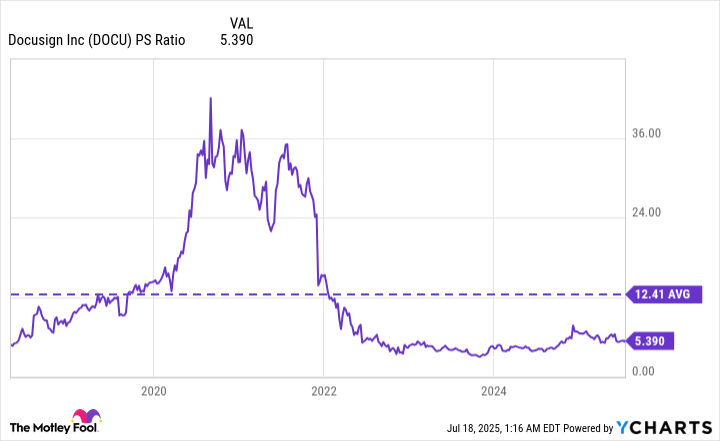Docusign (DOCU +1.25%) went public in 2018 at $29 per share, and by mid-2021, it had soared more than tenfold to a peak of $310. The COVID-19 pandemic drove incredible demand for the company's digital agreement platform, which allowed businesses to continue closing deals remotely while lockdown restrictions were in place.
But social conditions mostly returned to normal in 2022, leading to a slowdown in Docusign's business and a collapse in its stock, which is now trading 75% below its peak. Nevertheless, the company continues to grow at a steady pace, and it recently launched a new platform powered by artificial intelligence (AI) that could drive a fresh wave of demand from businesses of all sizes.
Here's why now might be a great time to buy Docusign stock on the dip.

Image source: Getty Images.
Solving a $2 trillion problem
Docusign's new AI-powered platform is called Intelligent Agreement Management (IAM), and it features a growing portfolio of tools designed to help businesses draft, negotiate, and close contracts. But it doesn't stop there, because it also makes contract management simpler and more predictable, so factors like expiry dates no longer sneak up on business owners unexpectedly. According to accounting firm Deloitte, poor contract management processes are costing businesses a whopping $2 trillion per year.
Navigator is one of IAM's flagship tools. It's a digital repository where businesses can store all their contracts, and it uses AI to automatically extract important information from each document. It makes that information discoverable through its special search function, so employees no longer have to dig through each individual contract to find details. Navigator also extracts renewal dates from each agreement, so businesses know well in advance when a contract will expire.
When new deals are being drafted, IAM's AI-Assisted Review tool can identify problematic clauses and even generate new ones to replace them, and it also serves as a chatbot that can answer questions to help businesses understand their risk. AI-Assisted Review isn't ready to replace a real legal team just yet, but it could drastically reduce the amount a business spends on legal advice, especially since businesses can set pre-approved standards so the tool remembers what to look for with each new agreement.
During the fiscal 2026 first quarter (which ended on April 30), Docusign said international IAM sales had soared by 50% from the fourth quarter of fiscal 2025, just three months earlier. IAM already has over 10,000 paying enterprise customers worldwide, but there is plenty of room for growth because Docusign has 1.7 million paying customers overall, and all of them could benefit from the AI platform.

NASDAQ: DOCU
Key Data Points
Docusign is carefully managing costs to fuel profitability
During the fiscal 2026 first quarter, Docusign delivered $763.7 million in revenue, which was only an 8% increase from the year-ago period, but it was well above management's forecasted range of $745 million to $749 million.
Docusign could be growing its revenue even faster if it spent more money in areas like marketing, as it did at the height of the pandemic. But the company is carefully managing costs to improve its bottom line. During the first quarter, Docusign's total operating expenses grew by just 1.6% year over year, and since revenue grew much faster, the company's operating profit soared by 166% to $60.2 million.
That translated to net income of $72.1 million, according to generally accepted accounting principles (GAAP), a jump of 113%.
Let's rewind for a moment to fiscal 2021, which ended on Jan. 31, 2021 (so it captured most of the pandemic-affected 2020 calendar year). Docusign grew its annual operating expenses by 37% which contributed to a 49% increase in the company's revenue, but it also resulted in a $243 million GAAP net loss. That followed a $208 million net loss the prior year and a $426 million net loss the year before that.
Pursuing growth by continuously burning money at the bottom line isn't a sustainable strategy over the long term, so Docusign made the right move by pivoting toward profitability instead. It might lead to slower revenue growth rates, but it will secure the company's future and ensure that investors won't face the dilutive effects of capital raises.
Docusign stock looks relatively cheap right now
Docusign stock was pricey when it peaked in 2021. Its price-to-sales (P/S) ratio surged to around 40, which wasn't sustainable without the rapid revenue growth from the pandemic era. Since that didn't continue, the valuation had to come down, which is why the stock is now 75% below its all-time high.
But the correction might have gone too far. Docusign's P/S ratio is now just 5.4, a steep discount to the company's long-term average of 12.4 when it went public in 2018.
DOCU PS Ratio data by YCharts
If Docusign continues to deliver consistent GAAP profits, we can eventually value its stock using the more traditional price-to-earnings (P/E) ratio. But its net income is a little too lumpy and unpredictable right now -- in fiscal 2025, for instance, the company booked a one-off tax benefit worth $819 million, which artificially inflated its earnings.
As things stand right now, Docusign stock looks like a very attractive buy based on its P/S ratio, so it could be a great addition to a diversified portfolio right now. Investors could be handsomely rewarded over the long term, especially if the company's IAM platform continues to gather momentum.






